The World Is Not Made of Particles or Waves – It’s All Fields! (Or How Does Light Actually Pass Through Materials?)
- katerinabiryukova
- Jul 22
- 5 min read
Updated: 4 days ago
Although we learn about scientific laws either in terms of particles (such as atoms, protons and electrons) or waves, the most accurate to-date theory, the Quantum Field Theory (QFT), states that particles (those “atom” balls we are used to seeing in textbooks and diagrams), are, in fact, not solid or spherical.
Introduction to Quantum Field Theory

Rather, you can imagine the world as an ocean. The ocean is filled with water - different quantum fields, and all these three-dimensional fields are everywhere around us and inside us, blending into each other. When there is a ripple (oscillation) in one of those fields, it produces a specific particle.
Light as a Particle
Light, which we observe every second of our lives, is in fact a particle called photon. A photon, in turn, is basically an excitation in the electromagnetic field.
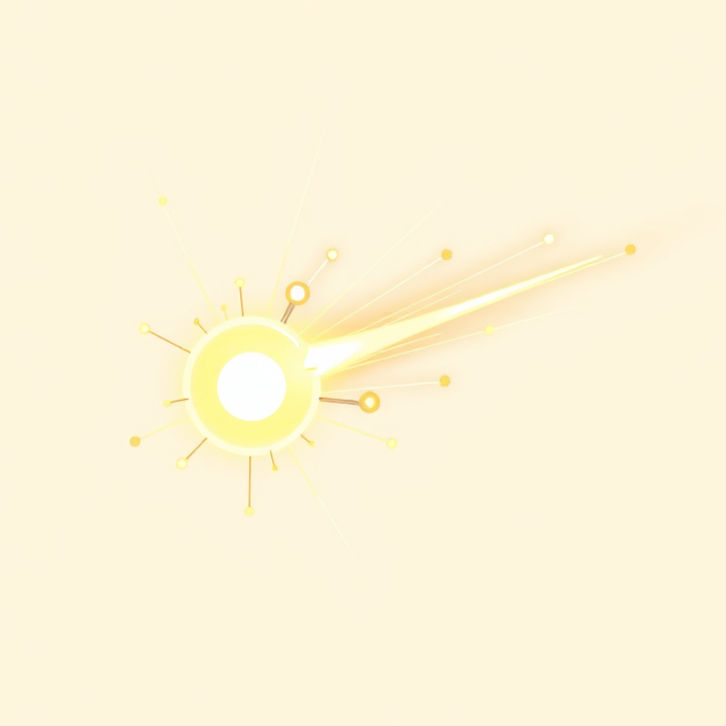
Mass of a Photon
Interestingly, photons do not have any mass. According to the QFT, there are certain types of symmetries associated with each quantum field, called gauge symmetries; these can also be represented by mathematical equations. However, in the case of photons, it is impossible to add the mass term into the equation without breaking the symmetry of the electromagnetic field, so photons are left massless (3).
In this article, we will consider only the light that we see (visible light) even though there are other types of light, like radio waves or ultraviolet light, in the electromagnetic spectrum.
An Extrordinary Behaviour of Light: Refraction
You may have seen this picture before – this trick that has been going around for quite a while. What physics concept do you think makes this trick possible and easy to carry out? Refraction.
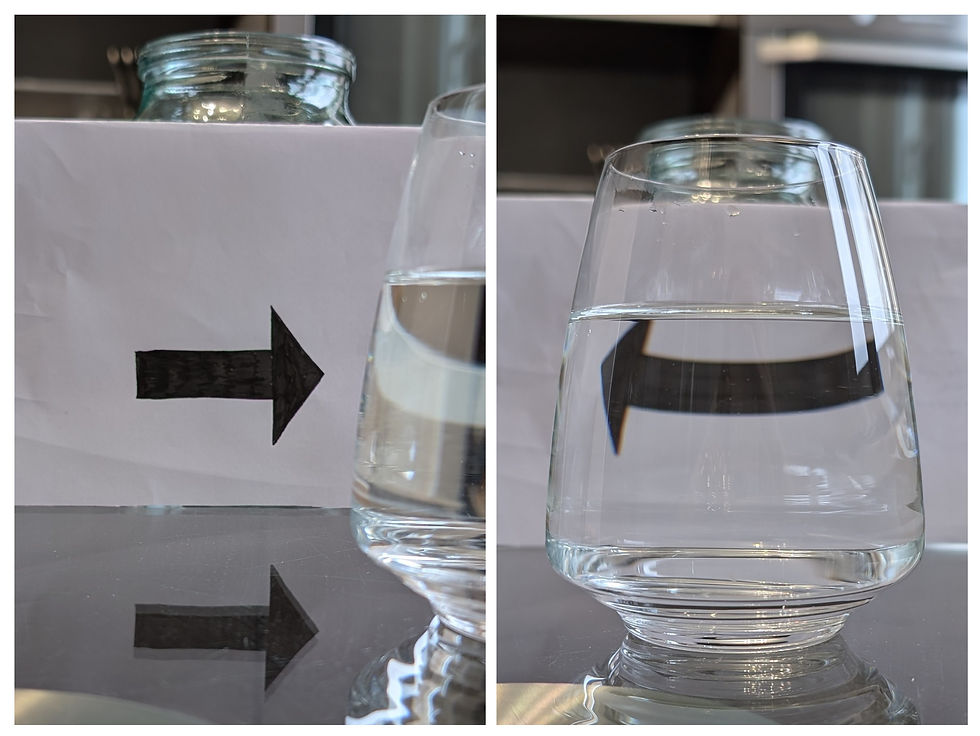
Refraction is when light enters a new substance and bends because light travels at different speed in different materials, referred to as different optical densities (1). Thus, as light goes from air to water (which is more optically dense than air) it slows down, and then, upon exiting water, it speeds up again. The final image that we see is altered.
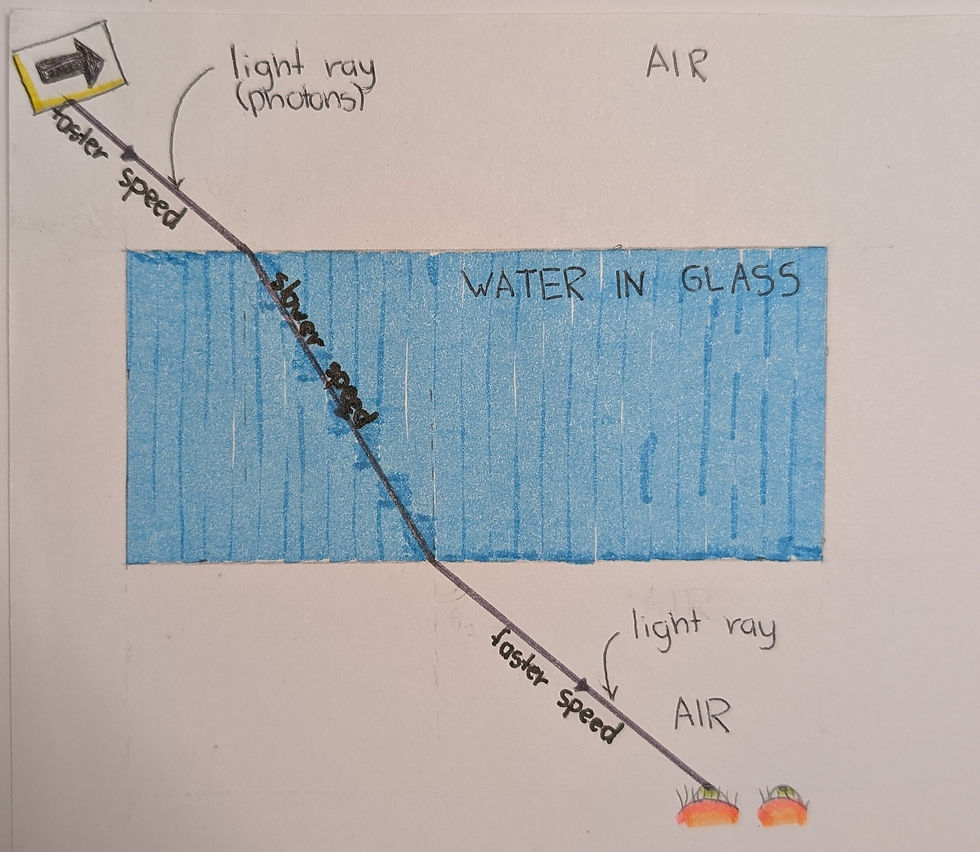
As a matter of fact, without refraction, up to 2.2 billion (this is the amount of people with vision impairment globally (2)) would have been deprived of acute eyesight! Indeed, refraction is utilized in both corrective glasses and lenses.

Why Does Refraction Happen?
However, nobody ever explains why refraction happens. The QFT can give the most precise answer to this question.
In the beginning of this article, we have already briefly touched upon the electromagnetic field, which is responsible for the existence of light, but there are other fields as well. There is a proton field, a small part of which vibrates at a certain distinct frequency to create protons. The electron/electric field, similarly, produces tremors which we call electrons.
Quarks and Gluons as Components of a Proton
In reality, a proton is not a fundamental particle as many of us are used to think. It is composed of even smaller particles: quarks and gluons. Therefore, there are more fundamental fields than the proton field, associated with each of these 2 particles, but, for this purpose, we will combine them into the proton field.
Now, let’s consider refraction (for example, when light goes from water to air) in terms of these fields. A Scottish mathematical physicist James Clerk Maxwell and his work at the end of the 19th century (so long ago!!!) will be the key to our puzzle.
Let’s imagine the following array of fields for simplicity. In truth, all of them are three dimensional and blended within each other. Note that we are going to be concerned only with the electric part of the electromagnetic field (there is also a magnetic part), which is depicted in green.

The "proton" and "electron" influences on the elecrtromagnetic field depict the manner in which the corresponding fields affect the electromagnetic field. The darkened blobs represent oscillations in the quantum fields, which constitute "particles" for the proton and electron field. As for the electromagnetic field, since only its electric component is shown, the blobs are not particles, but only influences in the field. Resource (4) Here are two other interesting pieces of information that will be useful henceforth:
Both the proton and the electron fields influence the electromagnetic field (i. e. any changes in either of those fields will be mirrored in the electromagnetic field, and vice-versa).
Because both protons and electrons are charged particles, they create an electric field.
According to Maxwell, the electric field is located perpendicularly to the direction in which light is travelling.

Adapted from resource (4) Now, this electric field is divided into two vectors (a vector is something that has a speed and direction): one that is parallel to the surface, where the two materials contact each other, and one that is perpendicular to that surface. Let’s imagine that there are two of each of these components: one for water, and one for air.

Adapted from resource (4) At the point where the light ray changes its substance (medium), “the electric field of the material and the electric field of air will have to ‘slide’ to have” oscillation in the same place. Otherwise, there would be a tear in the universe!

Adapted from resource (4) By doing some manipulations with two of Maxwell’s equations, it turns out that the perpendicular vector component for air must be larger than for water for step 4 to be true.

Adapted from resource (4) The last step is drawing the electric field for air and the new direction of light!
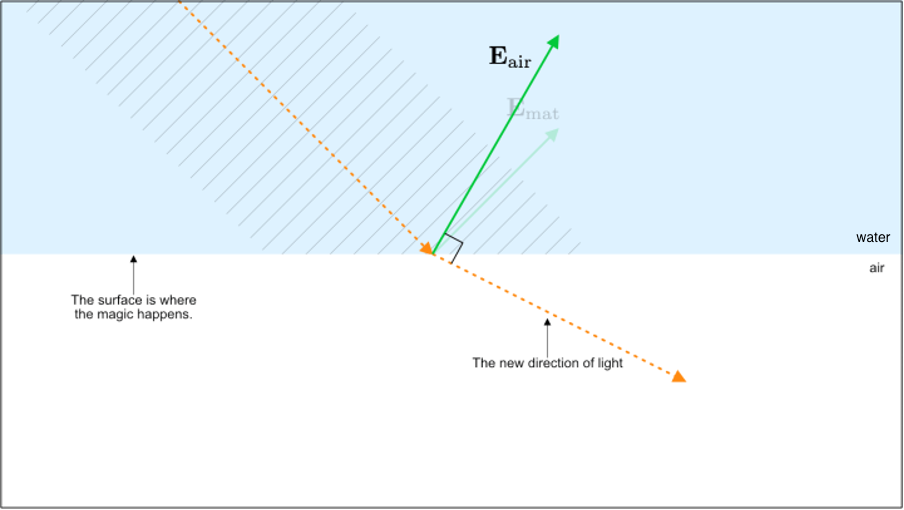
Why Different Speeds?
However, you may catch that we assumed that light travels at different speeds in different materials rather than deriving this principle. This conception is explained as follows:
When light enters a material, the incoming photons change the fluctuations of the electromagnetic field of that material. Therefore, the electric field of the material changes its vibrations as well to match the altered electromagnetic field. Thus, the arrangement of positive and negative charges of a material changes (4). This displacement of charges is called polarization, and it creates a “responding” electric field in the material.
Then, the electric field of the incoming photons combines with this “responding” field (which slightly opposes the incoming one (5)), and so light travels slower through the material.
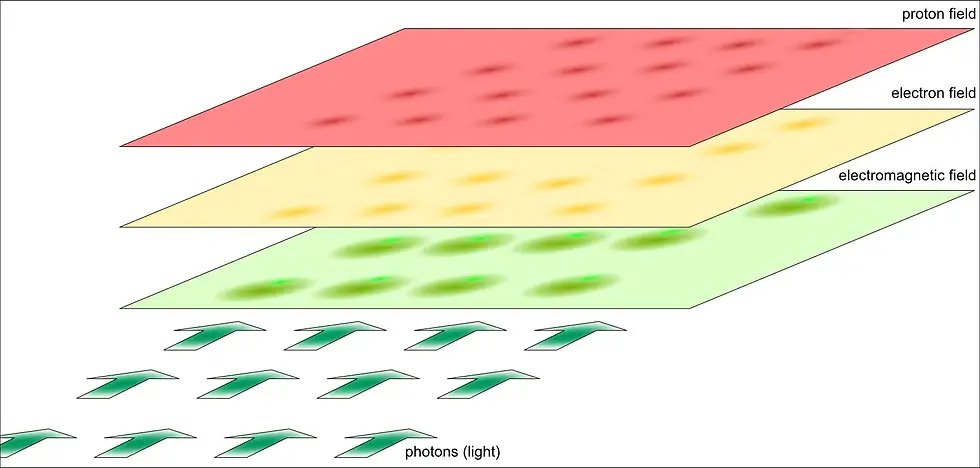
The polarization properties are different for different substances. If a material has higher polarization, then light will travel slower in it, and vice-verse.
To sum it up, incoming light alters the configuration of charges (electromagnetic configuration) in a material, which then changes "the trajectory of that same light"(4).
Turns out that eyeglasses that we wear on a day-to-day basis are much more multiplex than what they seem to be!
Conclusion
In summary, we took a look at the basic principle of Quantum Field Theory and discovered how interactions of quantum fields cause refraction of light in different materials.
Bibliography
Smith, Liam. Refraction, the Magical Manipulator of Light. Why Objects Look Different When Looking through Water - IX Power Clean Water. 20 Dec. 2023, ixwater.com/refraction.
World Health Organization. “Blindness and Vision Impairment.” World Health Organization, 10 Aug. 2023, www.who.int/news-room/fact-sheets/detail/blindness-and-visual-impairment.
Hirvonen, Ville. “Why Do Photons Not Have Mass? (Simple Proof).” Profound Physics, profoundphysics.com/why-do-photons-have-no-mass-simple-proof/.
Runia, KJ. “Why, Exactly, Do Glass and Liquids Refract Light? | OpenCurve.” OpenCurve, 30 June 2019, opencurve.info/why-exactly-do-glass-and-liquids-refract-light/. Accessed 17 July 2025.
“Speed of Light in Material.” Mit.edu, 2025, www.mit.edu/~ashrstnv/speed-of-light-in-material.html. Accessed 17 July 2025.
Comments